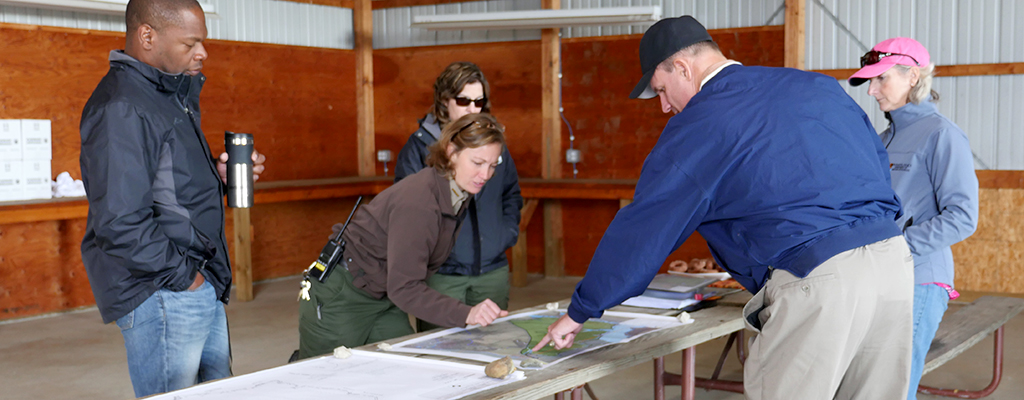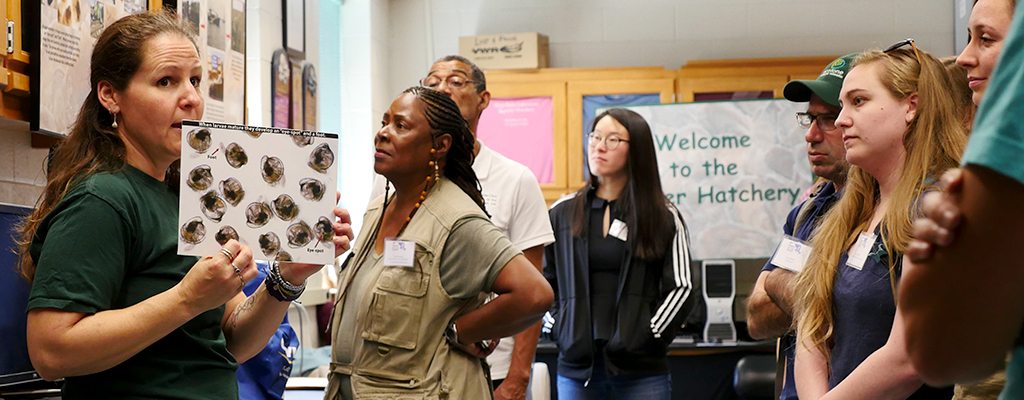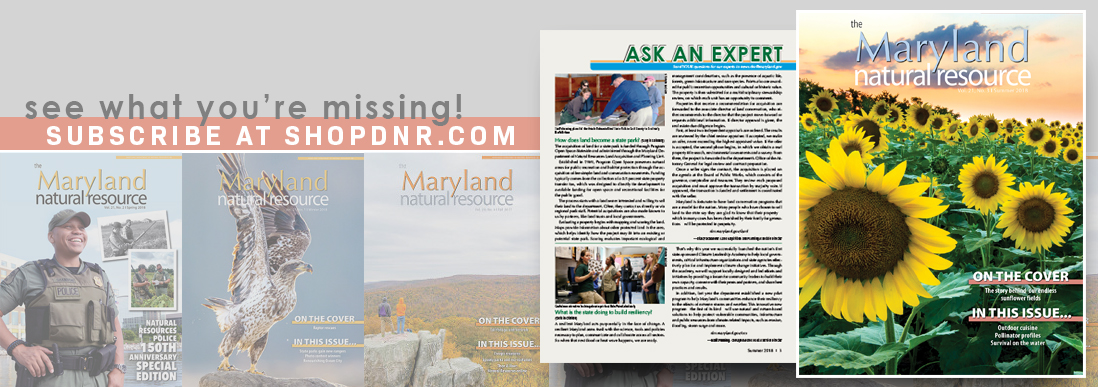Ask an Expert: Summer 2018
Do you know what it takes for land to become a state park? Have you heard about Maryland’s first Climate Leadership Academy? Our experts have the answers!

Staff showing plans for the future Bohemia River State Park to Secretary Belton; by Stephen Badger
How does land become a state park? (Sally in Salisbury)
The acquisition of land for a state park is funded through Program Open Space-Stateside and administered through the Maryland Department of Natural Resources Land Acquisition and Planning Unit.
Established in 1969, Program Open Space preserves natural areas for public recreation and habitat protection through the acquisition of fee simple land and conservation easements. Funding typically comes from the collection of a 0.5 percent state property transfer tax, which was designed to directly tie development to available funding for open space and recreational facilities for the public good.
The process starts with a landowner interested and willing to sell their land to the department. Often, they contact us directly or via regional park staff. Potential acquisitions are also made known to us by partners, like land trusts and local governments.
Evaluating a property begins with mapping and scoring the land. Maps provide information about other protected land in the area, which helps identify how the project may fit into an existing or potential state park. Scoring evaluates important ecological and management considerations, such as the presence of aquatic life, forests, green infrastructure and rare species. Points also are awarded for public recreation opportunities and cultural or historic value. The property is then submitted for a multidisciplinary stewardship review, on which each unit has an opportunity to comment.
Properties that receive a recommendation for acquisition are forwarded to the associate director of land conservation, who either recommends to the director that the project move forward or requests additional information. If director approval is given, the real estate due diligence begins.
First, at least two independent appraisals are ordered. The results are reviewed by the chief review appraiser. If accepted, we make an offer, never exceeding the highest appraised value. If the offer is accepted, the second phase begins, in which we obtain a real property title search, environmental assessments and a survey. From there, the project is forwarded to the department’s Office of the Attorney General for legal review and contract preparation.
Once a seller signs the contract, the acquisition is placed on the agenda at the Board of Public Works, which consists of the governor, comptroller and treasurer. They review each proposed acquisition and must approve the transaction by majority vote. If approved, the transaction is funded and settlement is coordinated with the seller.
Maryland is fortunate to have land conservation programs that are a model for the nation. Many people who have chosen to sell land to the state say they are glad to know that their property—which in many cases has been cherished by their family for generations—will be protected in perpetuity.
—Stacy Schaefer: Land Acquisition and Planning Associate Director

Conference attendees learning about oysters at Horn Point Lab; by Stephen Badger
What is the state doing to build resiliency? (Chris in Crisfield)
A resilient Maryland acts purposefully in the face of change. A resilient Maryland arms itself with the science, tools and policies necessary to plan, communicate and collaborate across all sectors. So when that next flood or heat wave happens, we are ready.
That’s why this year we successfully launched the nation’s first state-sponsored Climate Leadership Academy to help local governments, critical infrastructure organizations and state agencies effectively plan for and implement climate change initiatives. Through the academy, we will support locally-designed and led efforts and initiatives by providing a forum for community leaders to build their own capacity, convene with their peers and partners, and share best practices and results.
In addition, last year the department established a new pilot program to help Maryland’s communities enhance their resiliency to the effects of extreme storms and weather. This innovative new program—the first of its kind—will use natural and nature-based solutions to help protect vulnerable communities, infrastructure and public resources from climate-related impacts, such as erosion, flooding, storm surge and more.
—Matt Fleming: Chesapeake and Coastal Service Director
Have a question for our experts? Email us!


 1-888-373-7888
1-888-373-7888 233733
233733